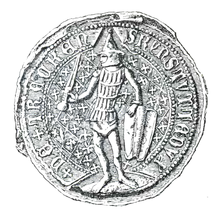Kęstutis
Kęstutis (German Kenstut or Kynstud ; * around 1297, † 1382 in Krėva ) was Grand Duke of the medieval Grand Duchy of Lithuania and Ruthenia . Gediminas ' son ruled for a long time together with his brother Algirdas († 1377). In contrast to Algirdas, the energetic Kęstutis developed his ambitions for power mainly in western Lithuania, came into permanent opposition to the Teutonic Order , and thus became the main adversary in its missionary expansion against Lithuania, which persistently blocked itself against Christianity , which had a lasting impact on his life .
Name interpretation
Spoken: [kæs.ˈtu.tıs]; known in Polish as Kiejstut, in Belarus as Кейстут; Alexander. The name " Kęstutis " is derived from the Lithuanian verb "kęsti" and means something like "the steadfast".
Enthronement
As the younger son of Grand Duke Gedimin , Kęstutis was only one of seven sons entitled to inherit his father, who died under dubious circumstances in 1341 near Georgenburg . First his older brother Jaunutis seized power, but soon had to share power with Algirdas . Latent discontent among the Lithuanian nobility eventually led to Janautis' disempowerment through joint action by Algirdas and Kęstutis. Unusually in the Middle Ages, this cooperation was to be maintained for a lifetime. Both agreed a strict delimitation of the spheres of interest, with Algirdas turning to the east, while Kęstutis ruled western Lithuania, namely Shamaites .
Reign 1347-1377
The rule was shaped by the sustained conflict with the Teutonic Order , which makes the sources about Kęstutis' domestic political activities appear rather sparse. The respective districts were devastated mainly by swarms. With such a move Kęstutis came into the power of the order in 1361, from which he was able to escape after a short time.
The hostilities resumed immediately and culminated in a concentric attack on the Order's land in the winter of 1370. The presence of Kęstutis' brother Algirdas shows that it was a final blow against the Order. The united Lithuanian-Russian-Tatar army advanced from the northeast towards Konigsberg . In the Battle of Rudau on February 17, 1370, the order faced the Lithuanian army under Grand Master Winrich von Kniprode and Order Marshal Henning Schindekopf . As a result of the meeting, the two grand dukes were forced to flee. Despite the severe defeat, their position of power remained safe. Soon afterwards, Kęstutis was able to send new troops against the order state. In this way, his reputation as warlord was restored, at least temporarily.
After 1377
Domestically, Kęstutis was confronted with new opponents in 1377 through the death of his loyal brother Algirdas. Algirdas' heirs, namely his sons Jogaila and Skirgaila , claimed the rule for themselves. This was the conflict that Kęstutis and his son Vytautas faced. Jogaila made use of the archenemy Kęstutis', the Teutonic Order, with which he concluded the secret Treaty of Daudisken on May 31, 1380, in the power struggle that soon followed. Kęstutis was then put under pressure by massive incursions by the knights of the order. In 1381 he attacked his nephew in Vilnius by surprise. Jogaila was taken prisoner but was soon released. In 1382 Kęstutis and Vytautas were captured by Jogaila, where Kęstutis died in August 1382 under unknown circumstances. Most contemporary sources speculate that he was strangled at Jogaila's orders.
See also
literature
- Hans Prutz : The orders of knights. Bechtermünz Verlag, Berlin 1908
- Wolfgang Sonthofen: The German Order. Weltbild Verlag, Augsburg 1995
- Dieter Zimmerling. The German Order of Knights. ECON Verlag, Munich 1998
Remarks
- ^ Karl Friedrich Pauli : General Prussian State History , fourth volume, publishing and printing by Christoph Peter Franckens, Halle 1763
| personal data | |
|---|---|
| SURNAME | Kęstutis |
| BRIEF DESCRIPTION | Lithuanian Grand Duke (1347 to 1377) |
| DATE OF BIRTH | around 1297 |
| DATE OF DEATH | August 1382 |
| Place of death | Krėva |

